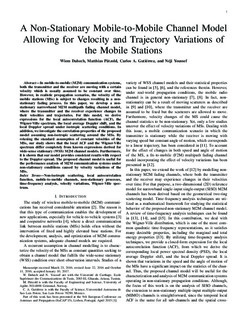| dc.description.abstract | In mobile-to-mobile (M2M) communication systems, both the transmitter and the receiver are moving with a certain velocity, which is usually assumed to be constant over time. However, in realistic propagation scenarios, the velocity of the mobile stations (MSs) is subject to changes resulting in a non-stationary fading process. In this paper, we develop a non-stationary narrow-band M2M multipath fading channel model, where the transmitter and the receiver experience changes in their velocities and trajectories. For this model, we derive expressions for the local autocorrelation function (ACF), the Wigner-Ville spectrum, the local average Doppler shift, and the local Doppler spread under isotropic scattering conditions. In addition, we investigate the correlation properties of the proposed model assuming non-isotropic scattering around the MSs. By relaxing the standard assumption of constant velocities of the MSs, this paper shows that the local ACF and the Wigner-Ville spectrum differ completely from known expressions derived for wide-sense stationary M2M channel models. Furthermore, it is shown that our model provides consistent results with respect to the Doppler spread. The proposed channel model is useful for the performance analysis of M2M communication systems under non-stationary conditions caused by velocity variations of the MSs. | nb_NO |
